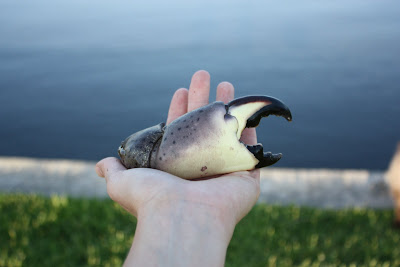Stone crab season opens October 15th, so we have loaded up three crab pots and dropped them along our dock filled with bait. We scored this nice grouper head from our local fish market.
Our crab pot
(Sea)life at the end of a dock.
Monday, October 17, 2011
After a 24 hour soak
Our first pull on a pot and we were excited to see this huge conch clinging to the side!
We later identified it as:
The horse conch (Pleuroploca gigantea), also known as the giant band shell, has been Florida's official state shell since 1969. This shell is native to the marine waters around Florida and can grow to a length of twenty-four inches. Young horse conchs have orange-colored shells; adults have orange apertures.
We also caught our first crab of the season, not huge but it looks tiny next to the horse conch!
Tuesday, April 19, 2011
Biggest claw yet!
 This is our most jumbo claw harvested yet! We have about five claws now, frozen and waiting to become a delicious appetizer.
This is our most jumbo claw harvested yet! We have about five claws now, frozen and waiting to become a delicious appetizer.
Interestingly, we have only caught stone crabs lately. Good for us, bad for my blog. We have spotted the first manatees of the season and I hope to get a shot of one soon!

A little guy.
It was also Betsy's fifth birthday!

Mullet and blue crab
 This was odd: a large school of mullet was milling around near the end of our dock and surfacing. I have no clue what they were doing but thought it was worthy of a photo!
This was odd: a large school of mullet was milling around near the end of our dock and surfacing. I have no clue what they were doing but thought it was worthy of a photo!

Here is John hauling the pot one beautiful morning. We had our first blue crab in the pot, but unfortunately my camera was on a black and white setting and I missed capturing his color.

Saturday, March 19, 2011
Oyster toadfish
 John grabbed the gloves and I grabbed the camera because another unexpected creature found it's way into the crab pot! It turns out this lovely guy is appropriately called a oyster toadfish, so here is your marine biology lesson for today:
John grabbed the gloves and I grabbed the camera because another unexpected creature found it's way into the crab pot! It turns out this lovely guy is appropriately called a oyster toadfish, so here is your marine biology lesson for today:Opsanus tau
Also known as the ugly toad, oyster cracker and "bar dog". The species can live in very bad conditions and needs little food to live. It is an omnivore. Common prey include crustaceans, mollusks, amphipods, squid, and other smaller fish. Toadfish rely upon camouflage to catch their food; they lie motionless waiting for prey to wander close by, then attack by surprise. They can be found anywhere from Maine to the Caribbean Sea.

Now you know!

Pinfish lesson
 The next day we took the girls down to the dock to do some fishing. We used live shrimp and a tiny hook and the fish started biting.
The next day we took the girls down to the dock to do some fishing. We used live shrimp and a tiny hook and the fish started biting.I had to go to the trusty world wide web to find out what it was: a pinfish.


Lagodon rhomboids
Pinfish make ideal bait for a wide variety of local species. Found grazing by the thousands throughout the shallow inshore waters, they’re often very easy to catch From spring to late fall large concentrations of pinfish inhabit just about every sea grass bed, bridge, pier, natural and artificial reef along both sides of the State. In the Gulf, you’ll also find pinfish actively foraging in the surf.
Now you know.
Blood blisters and birthdays
 The following are instructions on how to properly remove a claw:
The following are instructions on how to properly remove a claw:"Take hold of the claw with the crab facing away from you and give it a quick twist inward toward the mouth and it should snap off cleanly with no damage to the crab."
Easy, right? Well, John suffered his first pinch as a result.
 This picture doesn't do it justice....the blood blister looked much worse in real life!
This picture doesn't do it justice....the blood blister looked much worse in real life!After boiling this baby for 8 minutes, it took on a beautiful red color.

I should also mention that this all took place at Caitlin's third birthday party, so John was able to thrill the crowd with his injury.

Subscribe to:
Comments (Atom)






